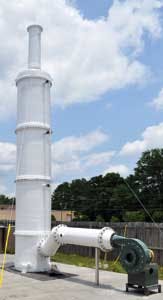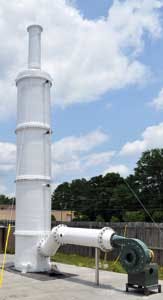Wastewater treatment plants often need to control the "rotten egg" odors resulting from their waste and sewage treatment processes. The unpleasant odors in and around wastewater plants are mainly caused by H2S, but other odorous compounds can include mercaptans, amines, aldehydes, and ketones.
In higher gas concentration applications, one alternative is Purafil's Biological Air Treater (BAT), which features a proprietary fixed-film trickling filter technology. Offered through an exclusive license with Honeywell Process Solutions, the system can provide more efficient and cost-effective odor abatement and VOC treatment than other biological removal systems.
Whereas other biofilters are challenged to maintain proper moisture and reduce pressure drops, the mixed media of foam cubes and spacers in a standard BAT have been proven to accomplish more than 99% removal of hydrogen sulfide gas. The polyurethane foam cubes provide incredible surface area per unit volume to host microbial biofilms.
Polypropylene spacers supply substantial void volume and structural integrity for tall beds, as well as enhanced mass transfer and excellent hydraulic dispersion and distribution. The unique mixed-media support allows for control of surface area and void space. Ratios of foam-to-plastic vary with engineering design and application, and are used to control the biofilm depth and pressure drop.
Purafil provides design assistance to the customer, to select the appropriate equipment based on the customer's requirements. The BAT system can be used to treat low and high airflows with hydrogen sulfide concentrations ranging from 25 ppm to 1000 ppm.
The system operates on electrical power and water supply. The water source can be either potable or re-use water from the wastewater treatment plant with at least 60 psi. The amount of water required to rinse out the sulfates generated by the biological reaction (usually 5-25 gpm) will depend on the H2S concentration. In a typical wastewater treatment plant application, using secondary treated effluent as a water source is recommended; not only is it economical, but this type of water often carries the nutrients needed by the bacteria in the biotrickling filter.
In order to design the appropriate biotrickling odor removal system, the following information is required:
- 1) Airflow
- 2) Gas concentrations (average and peak conditions)
- 3) Required removal efficiency (normally 99% for H2S and 90% for total odor)
- 4) Temperature of the airstream (this will normally be ambient but variations must be known)
- 5) Availability and quality of the water (including flow and pressure if possible)
- 6) Odor source (e.g. headworks, pump station, sludge storage, etc.)
An optional dry scrubbing polishing system is available to end-users and can increase the odor removal efficiency to more than 99.5%.
With any BAT sold, Purafil provides the vessel, media, blower and motor, recirculation pump, nutrient pump, complete water control cabinet, electrical control panel, system start-up and inoculation. Honeywell controls are offered as standard equipment on all Purafil BAT systems. A detailed scope of supply can be provided for any application.
Purafil is an exhibitor at the WEFTEC.12 event and can be found at Booth No. 1219




